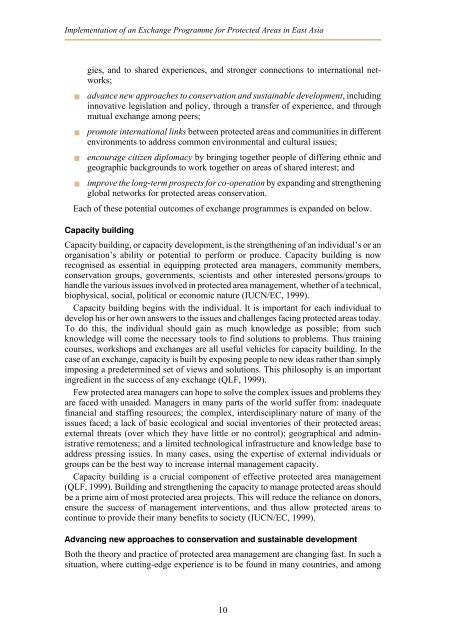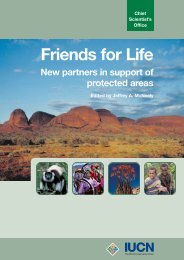Exchange programmes - IUCN
Exchange programmes - IUCN
Exchange programmes - IUCN
You also want an ePaper? Increase the reach of your titles
YUMPU automatically turns print PDFs into web optimized ePapers that Google loves.
Implementation of an <strong>Exchange</strong> Programme for Protected Areas in East Asia<br />
gies, and to shared experiences, and stronger connections to international networks;<br />
� advance new approaches to conservation and sustainable development, including<br />
innovative legislation and policy, through a transfer of experience, and through<br />
mutual exchange among peers;<br />
� promote international links between protected areas and communities in different<br />
environments to address common environmental and cultural issues;<br />
� encourage citizen diplomacy by bringing together people of differing ethnic and<br />
geographic backgrounds to work together on areas of shared interest; and<br />
� improve the long-term prospects for co-operation by expanding and strengthening<br />
global networks for protected areas conservation.<br />
Each of these potential outcomes of exchange <strong>programmes</strong> is expanded on below.<br />
Capacity building<br />
Capacity building, or capacity development, is the strengthening of an individual’s or an<br />
organisation’s ability or potential to perform or produce. Capacity building is now<br />
recognised as essential in equipping protected area managers, community members,<br />
conservation groups, governments, scientists and other interested persons/groups to<br />
handle the various issues involved in protected area management, whether of a technical,<br />
biophysical, social, political or economic nature (<strong>IUCN</strong>/EC, 1999).<br />
Capacity building begins with the individual. It is important for each individual to<br />
develop his or her own answers to the issues and challenges facing protected areas today.<br />
To do this, the individual should gain as much knowledge as possible; from such<br />
knowledge will come the necessary tools to find solutions to problems. Thus training<br />
courses, workshops and exchanges are all useful vehicles for capacity building. In the<br />
case of an exchange, capacity is built by exposing people to new ideas rather than simply<br />
imposing a predetermined set of views and solutions. This philosophy is an important<br />
ingredient in the success of any exchange (QLF, 1999).<br />
Few protected area managers can hope to solve the complexissues and problems they<br />
are faced with unaided. Managers in many parts of the world suffer from: inadequate<br />
financial and staffing resources; the complex, interdisciplinary nature of many of the<br />
issues faced; a lack of basic ecological and social inventories of their protected areas;<br />
external threats (over which they have little or no control); geographical and administrative<br />
remoteness; and a limited technological infrastructure and knowledge base to<br />
address pressing issues. In many cases, using the expertise of external individuals or<br />
groups can be the best way to increase internal management capacity.<br />
Capacity building is a crucial component of effective protected area management<br />
(QLF, 1999). Building and strengthening the capacity to manage protected areas should<br />
be a prime aim of most protected area projects. This will reduce the reliance on donors,<br />
ensure the success of management interventions, and thus allow protected areas to<br />
continue to provide their many benefits to society (<strong>IUCN</strong>/EC, 1999).<br />
Advancing new approaches to conservation and sustainable development<br />
Both the theory and practice of protected area management are changing fast. In such a<br />
situation, where cutting-edge experience is to be found in many countries, and among<br />
10






